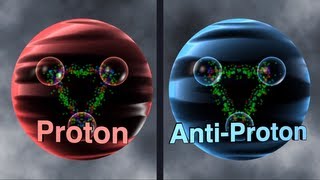(单词翻译:单击)
Is it possible to create something out of nothing?
凭空造物可能吗?
Or, more precisely, can energy be made into matter?
更确切地说,能量能转化成物质吗?
Yes, but only when it comes together with its twin, antimatter.
可以,但这需要在它和它的兄弟--反物质一起出现时。
And there's something pretty mysterious about antimatter:
关于反物质,有件很神秘的事:
there's way less of it out there than there should be.
它存在的量,远比它应有的量少。
Let's start with the most famous physics formula ever: E equals m c squared.
让我们从最有名的物理公式说起:E=mc^2
It basically says that mass is concentrated energy,
基本上是说,质量是浓缩的能量,
and mass and energy are exchangeable, like two currencies with a huge exchange rate.
而质量和能量是可以互换的,就像是汇率极高的两种货币。
90 trillion Joules of energy are equivalent to 1 gram of mass.
90万亿焦耳的能量等于1克的质量。
But how do I actually transform energy into matter?
要怎样才能把能量转换成物质呢?
The magic word is 'energy density'.
关键词是“能量密度”。
If you concentrate a huge amount of energy in a tiny space, new particles will come into existence.
如果你把巨大的能量集中到很小的空间,新的粒子就会出现。
If we look closer, we see that these particles always come in pairs, like twins.
如果我们看得更仔细些,我们会看到这些粒子总是成对出现,就像是双胞胎一样。
That's because particles always have a counterpart, an antiparticle,
因为每个粒子都有一个对应的伙伴,叫做反粒子,
and these are always produced in exactly equal amounts: 50/50.
它们总是依照50比50等量出现。
This might sound like science fiction, but it's the daily life of particle accelerators.
这听起来像是科幻小说,但对粒子加速器来说,却稀松平常。
In the collisions between two protons at CERN's Large Hadron Collider,
当两个质子在欧洲粒子物理研究所的大型强子对撞机中相撞,
billions of particles and antiparticles are produced every second.
每秒会产生数十亿个粒子与反粒子。
Consider, for example, the electron. It has a very small mass and negative electric charge.
比如说,像是电子。它的质量很小,而且带负电。
It's antiparticle, the positron, has exactly the same mass, but a positive electric charge.
它的反粒子,也就是正电子,质量完全相同,但是带正电。
But, apart from the opposite charges, both particles are identical and perfectly stable.
除了电荷相反以外,两种粒子一模一样,而且完全稳定。
And the same is true for their heavy cousins, the proton and the antiproton.
这对于它较重的表兄弟也成立,也就是质子与反质子。
Therefore, scientists are convinced that a world made of antimatter would look, feel, and smell just like our world.
因此,科学家相信,反物质组成的世界看起来、摸起来、闻起来都像我们的世界。
In this antiworld, we may find antiwater, antigold, and, for example, an antimarble.
在反世界中,我们可以找到反水、反金、或是,比如说,反弹珠。

Now imagine that a marble and an antimarble are brought together.
现在想象一下,弹珠和反弹珠放在一起。
These two apparently solid objects would completely disappear into a big flash of energy, equivalent to an atomic bomb.
这两个看似坚固的物体会完全消失,变成一大波能量,相当于一颗原子弹。
Because combining matter and antimatter would create so much energy,
因为将物质与反物质结合会产生极大的能量,
science fiction is full of ideas about harnessing the energy stored in antimatter, for example, to fuel spaceships like Star Trek.
科幻小说里面有许多用反物质储存能量的想法,例如《星际迷航》里宇宙飞船的燃料。
After all, the energy content of antimatter is a billion times higher than conventional fuel.
毕竟,反物质所含的能量是传统燃料的十亿倍。
The energy of one gram of antimatter would be enough for driving a car 1,000 times around the Earth, or to bring the space shuttle into orbit.
一克反物质的能量足够开车绕地球一千圈,或让航天飞机进入轨道。
So why don't we use antimatter for energy production?
为什么我们不用反物质产生能量呢?
Well, antimatter isn't just sitting around, ready for us to harvest.
这个嘛,反物质并不会坐等我们开采。
We have to make antimatter before we can combust antimatter,
我们必须先制造反物质,才能燃烧反物质,
and it takes a billion times more energy to make antimatter than you get back.
而要制造反物质得先花掉十亿倍未来可回收的能量。
But, what if there was some antimatter in outer space and we could dig it out one day from an antiplanet somewhere.
但如果宇宙中就有反物质,而且有一天能被我们从某处的反行星上开采出来呢?
A few decades ago, many scientists believed that this could actually be possible.
几十年前,许多科学家相信这是有可能的。
Today, observations have shown that there is no significant amount of antimatter anywhere in the visible universe,
现如今,观测结果显示,在已观察到宇宙的任何地方都找不到大量的反物质,
which is weird because, like we said before, there should be just as much antimatter as there is matter in the universe.
这是很诡异的,如我们先前所说,反物质的数量应该要和宇宙中物质的数量相等。
Since antiparticles and particles should exist in equal numbers, this missing antimatter?
因为反粒子和粒子存在数目应该相等,那么反物质到哪里去了?
Now that is a real mystery. To understand what might be happening, we must go back to the Big Bang.
这真是一个谜。为了明白可能发生了什么,我们必须回头看看大爆炸。
In the instant the universe was created, a huge amount of energy was transformed into mass,
在宇宙诞生的瞬间,大量的能量被转换成质量,
and our initial universe contained equal amounts of matter and antimatter.
最初的宇宙包含了等量的物质与反物质。
But just a second later, most matter and all of the antimatter had destroyed one another,
但仅仅一秒之后,大部分的物质及所有的反物质,就互相破坏消失了,
producing an enormous amount of radiation that can still be observed today.
产生我们至今仍观测得到的大量的辐射。
Just about 100 millionths of the original amount of matter stuck around and no antimatter whatsoever.
只有约一亿分之一的原始物质留了下来,没有任何反物质幸存。
"Now, wait!" you might say, "Why did all the antimatter disappear and only matter was left?"
“等等!”你可能会这么说:“为什么所有的反物质都不见了,而只有物质留下来?”
It seems that we were somehow lucky that a tiny asymmetry exists between matter and antimatter.
我们似乎很幸运,因为物质和反物质中有一点点不对称。
Otherwise, there would be no particles at all anywhere in the universe and also no human beings.
否则,这宇宙中将会没有任何粒子,也不会有人类。
But what causes this asymmetry?
是什么造成这种不对称呢?
Experiments at CERN are trying to find out the reason why something exists and why we don't live in a universe filled with radiation only?
欧洲粒子物理研究所的实验,正尝试找出“为什么有些东西留下来了、为什么我们的宇宙不是只充斥着辐射”的原因。
But, so far, we just don't know the answer.
不过,到目前为止,我们还是不知道答案。


